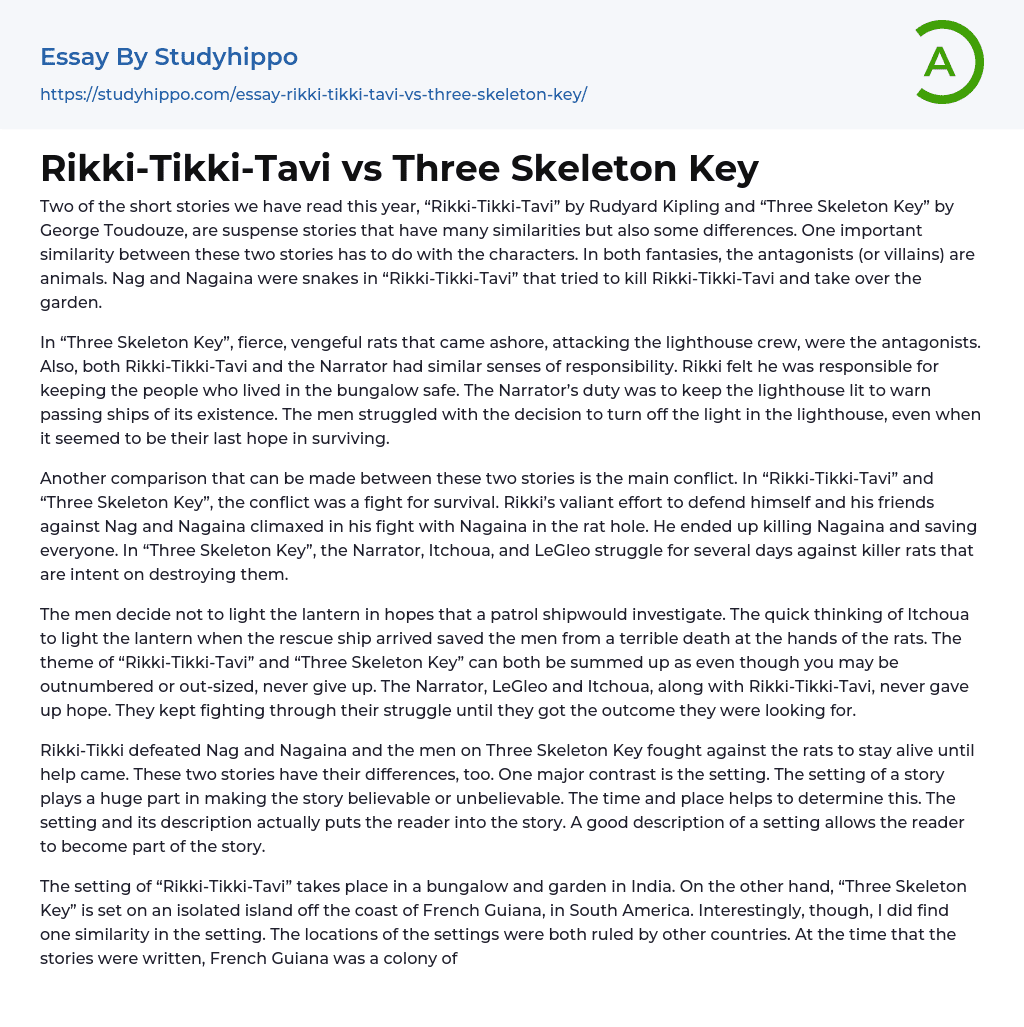This year's literature has exposed us to two intriguing short tales, Rudyard Kipling's "Rikki-Tikki-Tavi" and George Toudouze's "Three Skeleton Key". Both individualistic in their narratives, they nevertheless bear certain resemblances along with a few contrasts. The common narrative feature of both stories is the presence of adversarial characters embodied as animals. In particular, in "Rikki-Tikki-Tavi", the peril emanates from the serpent pair Nag and Nagaina who conspire to supplant Rikki Tikki Tavi and take over the garden.
In the story "Three Skeleton Key", the villains were vicious, revenge-seeking rats that launched an assault on the lighthouse crew. Similar levels of accountability were demonstrated by both Rikki-Tikki-Tavi and the Narrator. Rikki was under the impression that it was his responsibility to ensure the safety of the individuals residing in the bungalow. On the other hand
..., the Narrator felt obligated to keep the lighthouse beam functioning as a warning for passing vessels of its presence. Even when it appeared to be their only survival chance, the men found it challenging to decide on extinguishing the lighthouse's beam.
A parallel that exists between the two tales, “Rikki-Tikki-Tavi” and “Three Skeleton Key”, revolves around the principal dispute which is a life-or-death struggle. In "Rikki-Tikki-Tavi", Rikki courageously struggles to safeguard himself and his companions from Nag and Nagaina, culminating in a decisive battle with Nagaina in the rat hole. He triumphantly kills Nagaina ensuring everyone's safety. Similarly, in "Three Skeleton Key", the Narrator partners with Itchoua and LeGleo in battling a horde of murderous rats seeking to annihilate them over several days.
The men opted not to illuminate the lantern, banking on the possibility o
a patrol ship's investigation. Itchoua's swift action to ignite the lantern upon the arrival of the rescue vessel saved them from a horrific death by rats. The overarching themes of both "Rikki-Tikki-Tavi" and "Three Skeleton Key" revolve around persistence, regardless of being outnumbered or outsized. Characters like The Narrator, LeGleo, and Itchoua, along with Rikki-Tikki-Tavi, clung to hope ceaselessly. Knowing well their circumstances were dire, they bravely endured their trials until they reached their desired outcome.
Rikki-Tikki triumphed over Nag and Nagaina, while the men on Three Skeleton Key had to withstand a rat invasion to survive until rescue arrived. These narratives exhibit distinctive elements as well. An essential difference is the environment in which the story unfolds. The backdrop of a tale greatly influences its plausibility or implausibility – it is substantially dictated by the period and location. The setting, coupled with a detailed depiction, truly immerses the reader in the narrative. An adept delineation of a setting permits the reader's transition into an integral component of the tale.
"Rikki-Tikki-Tavi" and "Three Skeleton Key" take place in different settings - the first one is set in an Indian bungalow that has an attached garden, while the second takes place on a remote island near French Guiana in South America. Interestingly, both of these places were colonies when the stories were written - French Guiana was governed by France and India was under British rule. A slight difference between these two narratives lies in their storytelling perspectives - "Three Skeleton Key" is told from a first-person point of view by its narrator who serves as a lighthouse keeper.
The story "Rikki-Tikki-Tavi" is
narrated in the third person perspective. Both this narrative and another impart a sense of suspense, stirring curiosity and anticipation about the upcoming events. A deep understanding of the struggle for survival faced by the individuals in the lighthouse and Rikki-Tikki can be gleaned through these stories. The underlying message of remaining hopeful amid trials offers invaluable insights for everyone. The bravery exhibited by the protagonists can serve as a motivation for readers, promoting resilience in every phase of life.
- Allegory essays
- Alliteration essays
- Comedy essays
- Comic book essays
- Drama essays
- Dystopia essays
- Fairy Tale essays
- Fantasy essays
- Fiction essays
- Ghost essays
- Gothic Fiction essays
- Gothic Literature essays
- Irony essays
- Legend essays
- Memoir essays
- Novel essays
- Poetry essays
- Satire essays
- Science Fiction essays
- Short Story essays
- The western essays
- Tragedy essays
- Witchcraft essays
- Action Potential essays
- Blood essays
- Body essays
- Brain essays
- Childbirth essays
- Eye essays
- Glucose essays
- Heart essays
- Human Physiology essays
- Immune System essays
- Kidney essays
- Muscle essays
- Nervous System essays
- Neuron essays
- Poison essays
- Puberty essays
- Sense essays
- Skeleton essays
- Skin essays




